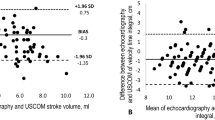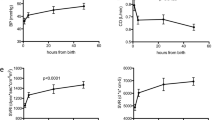Abstract
During neonatal resuscitation in the delivery room, heart rate guides clinical intervention, and although different methods have been evaluated as auscultation, pulse oximetry, and electrocardiography, they have various limitations. This was a prospective observational study which aim was to evaluate the accuracy and speed of ultrasound for measuring neonatal heart rate compared with stethoscope, pulse oximetry, and electrocardiography. Simultaneous determinations of heart rate using stethoscope, ultrasound, pulse oximetry, and electrocardiography were performed. Fifty term newborns were included. There were no differences according to the turn on time of the ultrasound, pulse oximetry, and electrocardiography (p = 0.666), but the placement time and the detection time from birth were shorter for ultrasound (p < 0.001). A stronger positive correlation was detected between ultrasound and electrocardiography at 90 (Rho = 0.926), and 120 s (Rho = 0.920) with p < 0.001. The Bland–Altman analysis showed a bias of − 2.23 (p = 0.129) between ultrasound and electrocardiography at 90 s, and a bias of 0.44 (p = 0.092) at 120 s. Instead, the bias between auscultation and electrocardiography at 90 s was − 6.71 (p = 0.131), and at 120 s was of − 4.67 (p = 0.793).
Conclusions: Ultrasound is a fast method to detect heart rate in the delivery room and has a good correlation with stethoscope and electrocardiography.
What is Known: • During neonatal resuscitation in the delivery room, heart rate guides clinical intervention, and although different methods have been evaluated, they have various limitations. What is New: • Heart rate ultrasound is a good and fast method to detect HR in the delivery room with a good correlation with electrocardiography and stethoscope. |



Similar content being viewed by others
Abbreviations
- HR:
-
Heart rate
- CPR:
-
Cardiopulmonary resuscitation
- PO:
-
Pulse oximeter
- ECG:
-
Electrocardiography
- US:
-
Ultrasound
- PEA:
-
Pulseless electrical activity
References
Wyckoff MH, Aziz K, Escobedo MB, Kapadia VS, Kattwinkel J, Perlman JM et al (2015) Part 13: neonatal resuscitation: 2015 American Heart Association Guidelines Update for cardiopulmonary resuscitation and Emergency cardiovascular Care – Part 13. Circulation. 132:543–560
Kamlin CO, O’Donnell CP, Everest NJ, Davis OG, Morley CJ (2006) Accuracy of clinical assessment of infant heart rate in the delivery room. Resuscitation. 71(3):319–321
Kamli CO, Dawson JA, O’Donnell CP, Morely CJ, Donath SM, Sekhon J et al (2008) Accuracy of pulse oximetry measurement of heart rate of newborn infants in the delivery room. J Pediatr 152(6):756–760
Katheria A, Rich W, Finner N (2012) Electrocardiogram provides a continuos heart rate faster than oximetry during neonatal resuscitation. Pediatrics. 130:177–181
Van Vorderen JJ, Hooper SB, Kroese JK, Roest AA, Naraven IC, van Zwet EW et al (2015) Pulse oximetry measures a lower heart rate at birth compared with electrocardiography. J Pediatr 166:49–53
Luong D, Cheung PY, Barrington KJ, Davis PG, Unrau J, Dakshinamurti S et al (2019) Cardiac arrest with pulseless electrical activity rhythm in newborn infants: a case series. Arch Dis Child Fetal Neonatal Ed 104(6):572–574
Sillers L, Handley SC, James JR, Foglia EE (2018) Pulseless electrical activity complicating neonatal resuscitation. Neonatology. 115:95–98
Patel S, Cheung PY, Solevag AL, Barrington KG, Kamlin COF, Davis PG et al (2019) Pulseless electrical activity: a misdiagnosed entity during asphyxia in newborn infants? Arch Dis Child Fetal Neonatal Ed 104(2):215–217
Clattenburg EJ, Wroe PC, Gardner K (2018) Implementation of the cardiac arrest sonographic assessment (CASA) protocol for patients with cardiac arrest is associated with shorter CPR pulse checks. Resuscitation. 131:69–73
Rodriguez-Fanjul J, Perez-Baena L, Perez A (2019) Cardiopulmonary resuscitation in newborn infants with ultrasound in the delivery room. J Matern Fetal Neonatal Med 10:1–4
Sweet DG, Carnielli V, Greisen G, Hallman M, Ozek E, Plavka R, Saugstad OD, Simeoni U, Speer CP, Vento M, Visser GHA, Halliday HL (2017) European consensus guidelines on the management of respiratory distress syndrome-2016 update. Neonatology. 111(2):107–125
Agrawal G, Kumar A, Wazir S (2019) A comparative evaluation of portable Doppler ultrasound versus electrocardiogram in heart-rate accuracy and acquisition time immediately after delivery: a multicenter observational study. J Matern Fetal Neonatal Med 27:1–8
Schmölzer GM, Morley CJ, Kamlin OCOF (2019) Enhanced monitoring during neonatal resuscitation. Semin Perinatol 43(8):151177
Murphy MC, De Angelis L, McCarthy LK, O’Donnel CPF (2018) Comparison of infant heart rate assessment by auscultation. ECG and oximetry in the delivery room. Arch Dis Child Fetal Neonatal Ed 103(5):490–492
Treston BP, Semberova J, Kernan R, Crothers E, Branagan A, O’Cathain N et al (2019) Assessment of neonatal heart rate immediately after birth using digital stethoscope, handhled ultrasound and electrocardiography: an observational cohort study. Arch Dis Child Fetal Neonatal Ed 104(2):227
Marshall S, Lang AM, Perez M, Saugstad OD (2019) Delivery room handling of the newborn. J Perinat Med 48(1):1–10
Phillipos E, Solevag E, Pichler G, Aziz K, van Os S, O’Reilly M (2016) Heart rate assessment immediately after birth. Neonatology. 109:130–138
Mercado P, Maizel J, Beyls C, Titeca-Beauport D, Joris M, Kontar L, Riviere A, Bonef O, Soupison T, Tribouilloy C, de Cagny B, Slama M (2017) Transthoracic echocardiography: an accurate and precise method for estimating cardiac output in the critically ill patient. Crit Care 21(1):136
Hodgson KA, Kamlin COF, Rogerson S, Thio M (2018) ECG monitoring in the delivery room is not reliable for all patients. Arch Dis Child Fetal Neonatal Ed 103(1):88
Raimondi F, Yousef N, Migliaro F, Capasso L, De Luca D (2018) Point-of-care lung ultrasound in neonatology: Classification into descriptive and functional applications. Pediatr Res 20:1–8
Singh Y, Tissot C, Fraga MV, Yousef N, Gonzalez Cortes R, Lopez J et al (2020) International evidence-based guidelines on point of care ultrasound (POCUS) for critically ill neonates and children issued by the POCUS Working Group of European Society of Paediatric and Neonatal Intensive Care (ESPNIC). Crit Care 24:–65
Acknowledgments
To the newborns and families which accepted to join the study.
Author information
Authors and Affiliations
Contributions
JRF, SBP, ABM, CS, and MR conceived and designed the study. MB, IJ, and SBP analyzed the data. JRF, SBP, MB, and IJ wrote the first draft of the manuscript. RF, ABM, CS, OO, and MR contributed to the writing of the manuscript. All authors agree with the manuscript results and conclusions, jointly developed the structure and arguments for the paper, made critical revisions, and reviewed and approved the final version of the manuscript.
Corresponding author
Ethics declarations
Conflict of interest
The authors declare that they have no conflict of interest.
Ethical approval
This study was approved by the local Ethical Assistance Committee and the institutional review board.
Informed consent
Obtained from all the parents of the participants.
Additional information
Communicated by Daniele De Luca
Publisher’s note
Springer Nature remains neutral with regard to jurisdictional claims in published maps and institutional affiliations.
Rights and permissions
About this article
Cite this article
Bobillo-Perez, S., Balaguer, M., Jordan, I. et al. Delivery room ultrasound study to assess heart rate in newborns: DELIROUS study. Eur J Pediatr 180, 783–790 (2021). https://doi.org/10.1007/s00431-020-03776-4
Received:
Revised:
Accepted:
Published:
Issue Date:
DOI: https://doi.org/10.1007/s00431-020-03776-4




